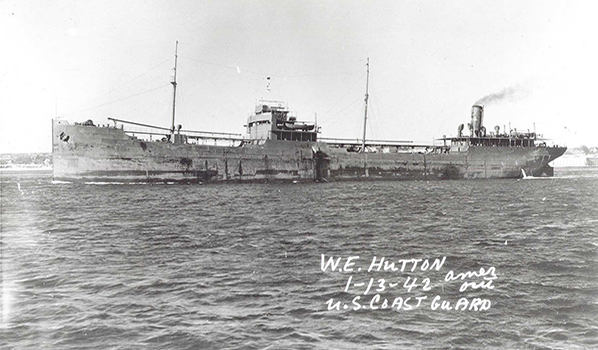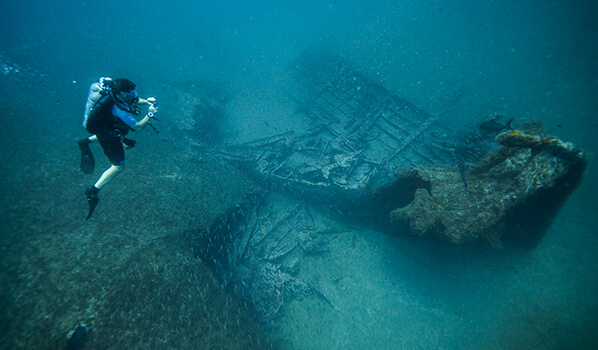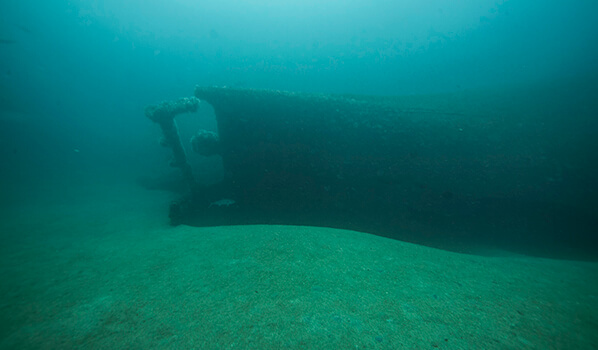W.E. Hutton
Ship Stats
Location: 34°8'37.2912"N, 76°39'8.4666"W (34.143692, -76.652352)
Depth: 125 feet
Vessel Type: Tanker
Length: 435.0 feet Breadth: 56.0 feet
Gross Tonnage: 7,076 Cargo: 65,000 barrels of #2 heating oil
Built: 1920, Bethlehem-Fairfield Shipbuilding Corporation, Alameda, California, USA
Hull Number: 219831 Port of Registry: Baltimore, Maryland, USA
Owner: Pure Oil Steamship Company, Nederland, Texas, USA
Lloyd's Register Details: Steel screw, 2 Decks, P.B. & F., Oil fired vessel, aft machinery, triple expansion 3 cylinder engine, 3 Scotch Boilers
Former Names: Portola Plumas (United States Shipping Board: 1920-1923)
Date Lost: March 19, 1942
Sunk By: U-124 Survivors: 23 of 36 survived (13 dead)
Data Collected on Site: Multibeam sonar data; still and video photography
Significance: Casualty of World War II's Battle of the Atlantic
Wreck Site
Today, the wreck site of W.E. Hutton sits off the Cape Lookout area near Beaufort, North Carolina. In 2016, a series of targeted multibeam surveys were conducted aboard the NOAA Ship Nancy Foster focusing on known wrecks sites. The survey of W.E. Hutton provided insight into site distribution and gave a detailed and accurate positioning of the wreck site. The multibeam image also provides baseline information for further site investigation.
Through historical research and with the assistance of the recreational diving community, NOAA believes it has identified the wreck site of W.E. Hutton. The confusion regarding the identification of some of the wrecks in the area stem from the USCG Gentian survey in 1943. This type of confusion is understandable with a large number of shipwrecks so close together and the "fog of war" effect.
Additionally, since 2008, with the assistance of local divers and avocational researchers, NOAA has determined that other initially reported shipwreck identities were incorrect and has been working to clarify their identities. Working with our partners, sites that had been identified as Mirlo, Papoose, W.E. Hutton, and San Delfino have now been more accurately identified as San Delfino, W.E. Hutton, Ario, and Papoose respectively (once believed Mirlo is in fact San Delfino; site of believed Papoose is actually W.E. Hutton; site of W.E. Hutton is Ario; and the site of believed San Delfino is actually Papoose).
NOAA continues to welcome information and data that can assist and strengthen ship histories, identification and personal stories.
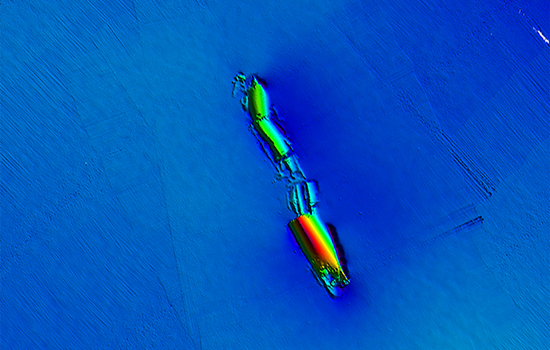
Historical Background
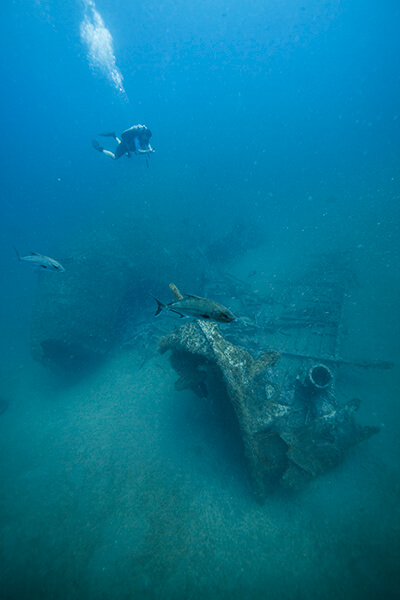
Originally named Portola Plumas, W.E. Hutton began its career as a cargo ship for the United States Shipping Board serving until 1923. That year, the Pure Oil Steamship Company of Philadelphia purchased the ship and renamed it W.E. Hutton, and it began service as a petroleum tanker.
On the night of March 18, 1942, W.E. Hutton was traveling from Smith's Bluff, Texas, to Marcus Hook, Pennsylvania, fully laden with 65,000 barrels of #2 heating oil. Regardless of the U-boat threat, the tanker transited unarmed and unescorted. Despite running lights out and black curtains engaged, as the tanker traveled north off the Cape Lookout area near Beaufort, North Carolina, U-124 spotted it.
Heading south, U-124's U-boat crew spotted the unsuspecting W.E. Hutton. Just a short while prior, U-124 sank the petroleum tanker Papoose, and now it had another tanker in its sights. In the early morning hours of March 19, U-124 decided to fire from the surface, firing two torpedoes towards the tanker. One torpedo missed, but the second hit the starboard bow, and the blast caved in the bow, flooded the forepeak and carried away both anchors. W.E. Hutton immediately sent a distress signal, the crew assembled on deck, and lifeboats lowered.
Hearing the emergency traffic, U-124 fired another torpedo towards the stationary tanker. The torpedo struck the port amidships section, under the bridge, buckling the decks and overturning the pilothouse. In just a few minutes, W.E. Hutton was a fiery inferno. The crew abandoned ship and shortly thereafter, W.E. Hutton slipped beneath the waves. The surviving crew began to row towards the shore with 12 survivors in one lifeboat, three in another, and four in each of two life rafts.
A year after the W.E. Hutton sank, the merchant vessel Suloide crashed into its wreckage and sank to the bottom. The U.S. Navy immediately dispatched the U.S. Coast Guard Cutter Vigilant (WPC-154) to clear the wreckage of W.E. Hutton to make the area safe for navigation.


